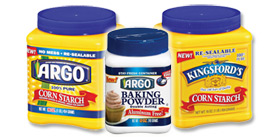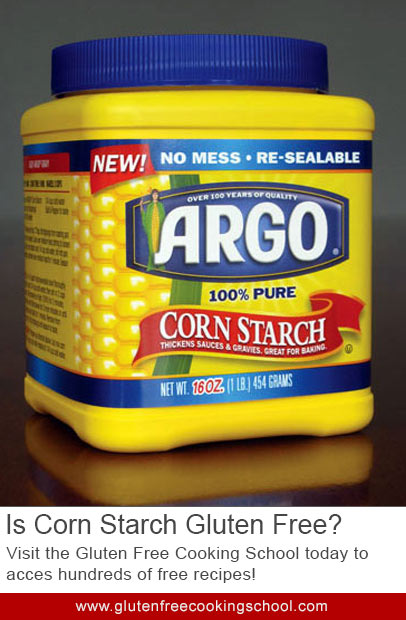5 Things That You Need To Know About Cornstarch If You Are Gluten Free
Cornstarch is naturally gluten free.
Corn is naturally gluten free. It is gluten free because it is not wheat, barley or rye. In a world without wheat, barley or rye, corn would always be gluten free. That’s not to say that everyone will choose to eat corn or cornstarch. They may avoid it because of it’s impact on their blood sugar levels, or because they have an intolerance or allergy to corn, or because they only eat non-GMO corn. However, corn in its unadulterate natural state is gluten free.
Not all cornstarch is gluten free.
I’m somewhat picky about cornstarch. Although corn is inherently gluten free, I do not trust that corn starch is gluten free by the time it gets to the supermarket shelves.
Is that distrust well-founded? I don’t know. Some companies like Clabber Girl make several brands of cornstarch; their Clabber Girl cornstarch is labeled gluten free, their Rumford cornstarch is not. I’d rather not worry about contamination, so I only use cornstarch that carries a gluten free label. If it’s certified to be gluten free, that’s even better.
My preferred brand of corn starch is Argo. It does carry a gluten free label and is widely available throughout the country under either the Argo or Kingsford brands. The screw-on lid container is also a huge plus because it makes it very easy to measure out the large quantities of corn starch that are needed in many gluten free recipes.

Cornstarch Is In Unexpected Places
Cornstarch is an ingredient in several other items that you probably keep in you pantry – baking powder and confectioner’s sugar (i.e., powdered sugar). Therefore it’s important to look for brands that contain at least a gluten free label when shopping for those too.
I usually buy Clabber Girl baking powder, which also carries a gluten free label.
I’ve had considerable trouble finding a brand of confectioner’s sugar that carries a gluten free label – so much trouble that I don’t feel comfortable recommending a brand.
My rule of thumb is to always read labels, and if a product contains cornstarch then I only buy that product if it also has a gluten free label.
If you can’t find gluten free baking powder or confectioner’s sugar, you can always buy gluten free corn starch and then make the baking powder and confectioner’s sugar at home.
Cornstarch (or some starch) is necessary for good gluten free baking
Someone recently asked on one of Gluten Free Cooking School’s Facebook groups if the amount of cornstarch in a recipes was a mis-print. “Surely,” they said “that’s too much. I’ve never used that much corn starch in my life!”
As much as I hate, from a nutritional aspect, to use cups of cornstarch in a recipe, I still use it. When I bake gluten free, I want my recipe to test as good or better than the best gluten-filled recipe that you’ve ever had. Large amounts of starch make this possible. Of course, that doesn’t mean that you have to eat those foods every day. We limit the high-starch, high sugar foods to one day a week.
Gluten Free, Corn-free Alternatives Do Exist
If you can’t have corn, or just prefer not to eat it, then stock up on the gluten free versions of other starches like tapioca and arrowroot. You can make your own baking powder and confectioner’s sugar from scratch using these and be all set for gluten free, corn free baking.

The same here, my go-to corn starch is Argo. It is a heaven sent for those with who doesn’t want or can’t any gluten in their diet just like myself.
Good morning fellow bakers..wherever you are.
In UK we have the Coeliac UK Food and drink directory..its a handbag siized book..that lists all the ” safe” products for us..so that when we shop..we can do so with confidence. However, there is nothing like reading the labels of everything that you are going to consume..before you purchase.
Is there something like this in the USA?
With love and best wishes for your continued good health
Janet
Janet, there are similar guides for the U.S. I’ve tried to use them before but found them time-consuming. The grocery store chains in the U.S. are very regional and they each have their own private label products in addition to carrying some national brands. And even the national brands are use different names and labels in different parts of the U.S.
Does anyone in the U.S. find these sort of books/apps useful?
A great brand of gluten free confectioner’s sugar is Wholesome Sweeteners. Their regular gluten free organic confectioner’s sugar has corn starch, but for those of us (like me) who can’t have corn, they make a superfine confectioner’s sugar with tapioca starch that is also gluten free and corn free. It’s available in Canada and I think also the USA. Thought I’d let you all know 🙂
One reason for ALWAYS checking the labels, rather than depending on the books or the past experience, is that they may change ingredients. Same brand, same product, but ingredients listed are not always the same.
Mary,
Many people that are sensitive to gluten are also sensitive to corn because in it’s “natural state” it contains it’s own gluten which is nothing more than the protein of the grain. This can often mean that ANY grain may end up being a problem for people with gluten sensitivities. I am not allergic to corn but I got the same reaction to corn gluten that I got to the wheat. Here is the thing, any grain has a protein so the possibility exists that when you go gluten free and you still don’t feel well (as I did) and you are still having cravings then it may be one of the other grains. Corn is NOT gluten free otherwise dog food manufacturers would not put in “corn gluten” to boost the protein value of the food. Thank you for providing such a great service to people with this condition but please understand that not allergy but the same kind of thing as what happens with wheat can and does happen with corn. I sincerely hope you never have to give up yummy corn but I had to.